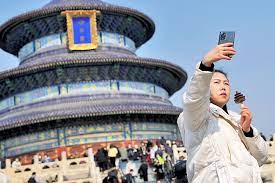China unleashes great economic momentum after COVID-19 victory

Beijing: After achieving a major and decisive victory in its COVID-19 prevention and control efforts since late 2022, China has put its economy back on the fast track, with the vigor of its development impacting the whole world.
At a meeting last week, the Chinese leadership noted that China’s COVID-19 response has accomplished a smooth transition in a relatively short time, citing continuous efforts made in optimizing relative prevention and control measures since November 2022.
With enhanced social mobility and international exchanges, the world’s second largest economy is on course for a robust economic comeback.
The strong resilience of the Chinese economy can be seen in certain key statistics.
In January, the country’s manufacturing sector regained expansion after three consecutive monthly shrinkages, with the purchasing managers’ index reaching 50.1, up from 47 in December, data from the National Bureau of Statistics showed.
A reading above 50 indicates expansion, while a reading below reflects contraction.

The national consumer price index last month rose by 2.1 percent year on year. Compared with the price surge of major developed economies in the world, China’s overall price level runs in an appropriate range, making the country an important “stabilizer” of global prices.
According to an earlier State Council executive meeting, China aimed to consolidate and expand the momentum of economic rebound, accelerate the recovery of consumption and stabilize foreign trade and investment.
As China has optimized its epidemic prevention and control measures, the flow of people, goods and information has brought much vitality to the country.
As the world’s second largest consumer market, China has been expanding its consumption, injecting new momentum into the global economic recovery.
After a three-year lapse, China’s outbound group tour has restarted, with the first batch of tour groups arriving in Thailand, the United Arab Emirates and other countries.
According to a forecast of the UN World Tourism Organization, the orderly restoration of the outbound travels will greatly promote the recovery of tourism in the Asia-Pacific region and even the whole world. The labor market has also been buzzing.
At the beginning of the Chinese Lunar New year, which started on Jan. 22 this year, labor-intensive provinces like Jiangsu, Zhejiang and Fujian launched cross-province recruitment. Government departments have led teams to central and western provinces to offer job information from enterprises and explain the recruitment policies.
Yang Daoling, a researcher with the State Information Center, said that the average flow of people around 100 representative incubators in January increased by 17.6 percent from the previous month.
The Spring Festival travel rush, a mass-migration event marking the celebration of the Chinese New Year, witnessed more than 1.5 billion trips made by rail, highways, waterways and civil aviation in 40 days. The figure marked a 50.5-percent increase over the same period in 2022.
Goods also moved at a faster pace. The country’s courier companies hit the 10-billion-parcel mark within the first 39 days of 2023, which is 40 days quicker than in 2019, before the COVID-19 epidemic struck.
This year’s performance demonstrates the vitality, resilience and growth potential of China’s express delivery industry, the State Post Bureau said, adding that it shows that consumer confidence is increasing, and the economic recovery is picking up pace.
The rebound of the Chinese economy has attracted global attention as well as sparking interest among international investors.
The foreign direct investment (FDI) into the Chinese mainland, in actual use, expanded 14.5 percent year on year to 127.69 billion yuan in January, according to the Ministry of Commerce.
High-tech industries saw a rapid FDI increase of 62.8 percent in January. Specifically, foreign investment in high-tech manufacturing surged 74.5 percent, while that in the high-tech service sector rose 59.6 percent.
Meng Huating, a Commerce Ministry official, said the country will actively guide foreign investment in sectors including advanced manufacturing, modern services, energy conservation and environmental protection, and will continue to attract investment in high-tech industries.
After international investment banks and financial institutions, including Morgan Stanley, Goldman Sachs, HSBC, Barclays and Natixis, upwardly revised their 2023 forecasts for China, the International Monetary Fund (IMF) also lifted its growth forecast of China’s economic growth rate this year.
“Growth in China is projected to rise to 5.2 percent in 2023, reflecting improving mobility,” the IMF said in an update to its World Economic Outlook report. The updated number was 0.8 percentage points higher than the October 2022 forecast.





